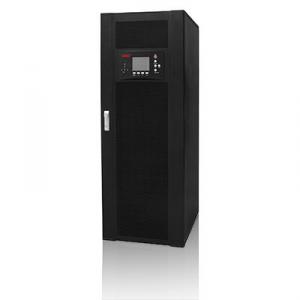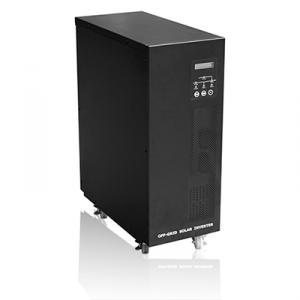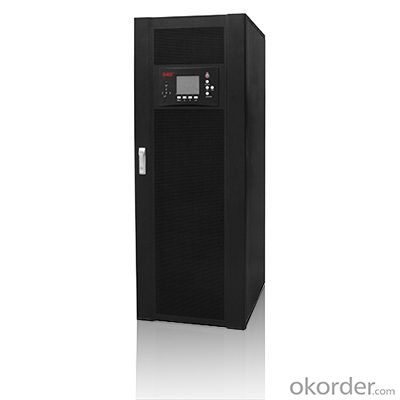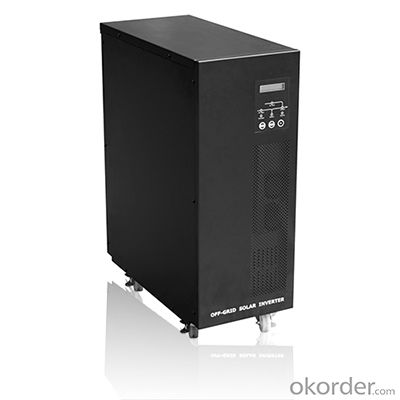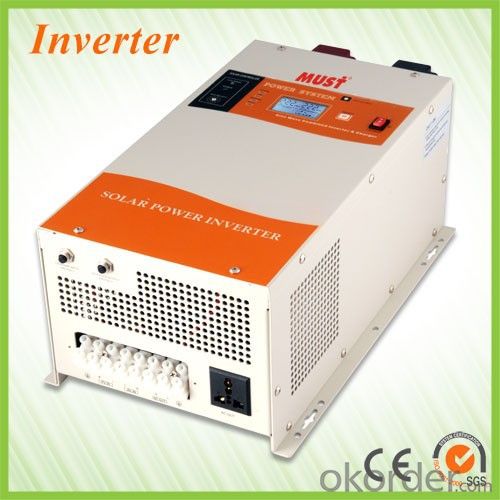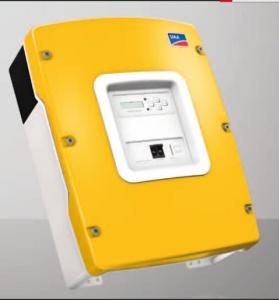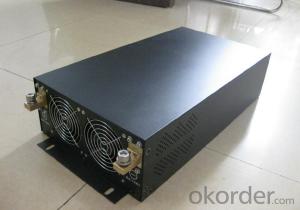Solar Inverter for Sale - Off-Grid Solar Inverter 10kVA-120kVA Made in China High Intelligence
- Loading Port:
- China main port
- Payment Terms:
- TT or LC
- Min Order Qty:
- 1 pc
- Supply Capability:
- 1000 pc/month
OKorder Service Pledge
OKorder Financial Service
You Might Also Like
Off-Grid Solar Inverter 10KVA-120KVA
EA-GF series products use high speed DSP control unit, advanced high speed IGBT, MOSFET components, with pulse width modulation (SVPWM) technique disturbance type MPPT control, and double conversion system configuration. Under high-speed DSP system control, the system can quickly track panels to do high-power, load change and efficient multi-level control system, even if the mains input voltage and frequency suddenly change, over/under voltage, or power disturbances, it also can ensure provide the load with regulated voltage and frequency power. System has a reliable, environmentally friendly, high intelligence and other characteristics.
Villa, hotel, residential security, large base station, office, small manufacturing enterprises, computing centers, industrial automation equipment, network room, IDC data center, banking equipment, securities, health care, transportation, petrochemical and other solar systems.
● High reliability:
※ High-speed micro-controller DSP digital control technology to achieve real-time control, parameter setting, data detection, self-test function to ensure high reliable operation of the system.
※ With high speed switching characteristic, high voltage, high current, low internal resistance, low dissipation IGBT, MOSFET power components based, to ensure system security and reliability.
● N+1 modularized MPPT tracking system:
※ Multipath MPPT control system access, independent input, operation. More suitable for roof project, to improve power generation efficiency of the panels.
● PV proactive power supply function:
After detects PV energy, system will enter MPPT status automatically, and it will also adjust the power distribution, priority in the use of PV energy.
● Intelligent battery management system:
※ In this system, AC rectifier 、MPPT controller controlled by intelligent data exchange and communication system,user can set the battery capacity by themselves;battery configuration can be set by the operator interface,system will automatically
adjust the charging current ,charging voltage and charging mode.
※ In special cases,international technical engineer can adjust the charging rate and battery number according to the system configuration.
● Plenteous communication interface:
※ RS485、RS232 (standard),SNMP(Option).
※ Input dry contacts to switch on/off inverter, clear abnormal, EPO remotely. Output dry contacts singles for remote alarm.
● Intelligent storage staggering features:
System with intelligent peak load shifting function, the user can set the appropriate time period electricity according to the local electricity policy, to achieve load shifting features directly in order to bring economic value;
Model | 10KVA | 20KVA | 30KVA | 40KVA | 50KVA | 60KVA | 80KVA | 100KVA | 120KVA | |
Rated Power(KW) | 9KW | 18KW | 27KW | 36KW | 45KW | 54KW | 72KW | 90KW | 108KW | |
Rated Current (A) | 15A | 30A | 45A | 60A | 76A | 91A | 133A | 151A | 182A | |
Output Power Factor | 0.9 | |||||||||
Rated Input Voltage | 380V±20% | |||||||||
Rated Output Voltage | 380V±1% | |||||||||
Battery Voltage | 360Vdc | |||||||||
Battery Quantity | 30 units, 12V | |||||||||
Working Mode | PV、AC replenish | |||||||||
PV Input | Max Voltage | 750Vdc | ||||||||
Best Working Voltage(Vmp) | 444-550Vdc | |||||||||
Float Charging Voltage | 414V±1% | |||||||||
Max Efficiency | ≥98% | |||||||||
Equalize Charging Voltage | 428V±1% | |||||||||
Max Current | 40A | 60A | 120A | 180A | 240A | 300A | 360A | |||
PV Input Ways | 1+1(reserved) | 2+1(reserved) | 3+1(reserved) | 4+4(reserved) | 5+3(reserved) | 6+2(reserved) | ||||
MPPT Modular | 1+1(reserved) | 2+1(reserved) | 3+1(reserved) | 4+4(reserved) | 5+3(reserved) | 6+2(reserved) | ||||
AC Rectifier | Input Voltage Range | Three phases 380V ±20%(-10%~+20% can charge the battery) | ||||||||
Rated Frequency | 50 Hz / 60Hz(can be set backstage) | |||||||||
Frequency Range | 50Hz/60Hz±5Hz | |||||||||
Soft Start | 0-100% 10s | |||||||||
Power Factor | 0.8 | |||||||||
Float Charging Voltage(20℃) | 410V±1% | |||||||||
Max Voltage | 415V±1% | |||||||||
Max Charging Current(A) Battery Capacity Allowed | 12 | 25 | 38 | 50 | 62 | 75 | 80 | 100 | 120 | |
Inverter | Inverter Voltage | Three phases four lines +G 380Vac | ||||||||
Phase Voltage Setting | 220-230-240Vac(can be set backstage) | |||||||||
Output Voltage Accuracy | ±1% | |||||||||
Voltage Transients Range | ±5% | |||||||||
Transient Recovery Time | 20ms | |||||||||
Rated Frequency | 50Hz/60Hz±1% | |||||||||
Frequency Tracking Range | 50Hz/60Hz±3Hz | |||||||||
Crest Factor | 3:1 | |||||||||
Wave | Pure sine wave | |||||||||
THD | ≤3%(linear load) | |||||||||
Voltage Unbalance Degree | ±3%(100%unbalance load) | |||||||||
Overload | ≥105%-110%: transfer to bypass 1 hours later, recover when reduce load ≥110%-125%: transfer to bypass10 min later, recover when reduce load ≥125%-150%: transfer to bypass 1 min later, recover when reduce load ≥150%: transfer to bypass 10 s later, recover when user confirmed ≥200%: shutdown immediately, recover when user confirmed | |||||||||
Short Circuit | System current limited, shut down immediately, boot by user | |||||||||
Max Efficiency % | ≥90% | ≥91% | ≥92% | ≥92% | ≥93% | ≥93% | ≥93% | ≥93% | ≥93% | |
Bypass | Rated Voltage(V) | Three phases four lines+G 380Vac | ||||||||
Voltage Range | ±20% | |||||||||
Rated Frequency(Hz) | 50/60Hz±5Hz | |||||||||
Max Current | 19 | 38 | 57 | 76 | 95 | 114 | 122 | 152 | 182 | |
Battery Management | End of Discharge | 315VDC | ||||||||
Charging Current Setting | Factory setting is 0.15C10 ; user can set 0.05-0.3 C10 | |||||||||
Charging Current Setting | Equalizing charging and float charging automatically transfer, automatic temperature compensation for battery (when battery detection not connected, default environment temperature) | |||||||||
Staggering Depth of Discharge Settings | 1.85V-2.1V; can be set by user | |||||||||
Transfer Time | Inverter/Bypass Transfer Time | 0ms | ||||||||
Inverter/Bypass Transfer Time | 0ms | |||||||||
Communication Interface | Remote Control Input | Inverter on、off、abnormal clear、emergency power off | ||||||||
PC Monitoring Interface | RS232、RS485、SNMP (optional) | |||||||||
Dry Contact | Bypass input abnormal、rectifier input abnormal、system fault、system warning、 low battery、overload 、fans fault、generator ON/OFF | |||||||||
Environment | Operation Temperature | 0-42℃ | ||||||||
Max. Relative Humidity | 90% (non condensed) | |||||||||
Max. Working Altitude | 1000m (100 m higher, 1% derated; max 4000m) | |||||||||
Other | Cooling Way | Forced ventilation (Fans speed varies with the load) | ||||||||
Noise(1m varies with load and temperature )dB | 65 | |||||||||
Mean Time Between Failures(MTBF) | 200,000 hours | |||||||||
Defend Grade(EN60529) | IP20 | |||||||||
Power Line Input | Bottom | |||||||||
Standard | IEC62040-1-1、EN62109-1:2010, EN62109-2:2011 | |||||||||
Dimensions(WxDxH)mm | 600×700×1750 | 1000×800×1700 | ||||||||
Packing Dimensions(WxDxH)mm | 690×790 ×1850 | 1090×890 ×1800 | ||||||||
Weight | 250 | 280 | 300 | 320 | 345 | 360 | 400 | 420 | 445 | |
· Q. What is an UPS and What it is for ?
An uninterruptible power supply (UPS) is a device that allows your computer or telephone switch or critical equipement to keep running for at least a short time or longer time when the primary power source is lost. It also provides protection from power surges, spikes, brownouts, interference and other unwanted problems on the supported equipment.
· Q. How long the UPS to run when power goes?
This can take 3 paths.
1.You can pick a UPS that is rated for pretty much the full VA you need so it will be running at 100% of capability and will thus last 'n' minutes.
2.You can pick a UPS that is rated at a much higher VA value than you really need so, for example, is running at 50% of capability and will thus last for longer than the UPS from option 1.
3.You can use extra external battery packs to run for longer. If charging capability allows, the more and the bigger batteries you take with, the longer time UPS runs.
or using a generator after about 6 hours, it will be more cost-effective, with a short runtime UPS to bridge the generator start-up gap.
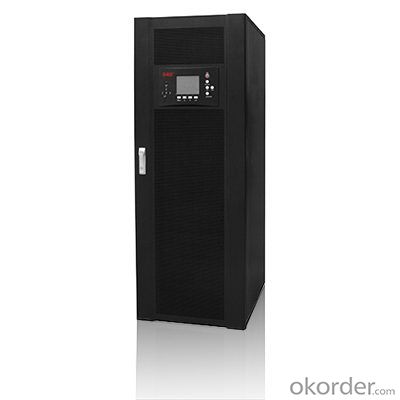

- Q: What are the common maintenance requirements for a solar inverter?
- Some common maintenance requirements for a solar inverter include regular cleaning to remove dust and debris, checking for loose connections or wiring issues, monitoring performance and output levels, and ensuring proper ventilation to prevent overheating. It is also important to keep an eye on the inverter's display for error messages or any signs of malfunctioning. Regular inspections and maintenance by a qualified technician are recommended to ensure optimal performance and longevity of the solar inverter.
- Q: What is the typical size and weight of a solar inverter?
- The typical size and weight of a solar inverter can vary depending on its power capacity. Generally, residential solar inverters range in size from around 30 x 50 x 20 cm (12 x 20 x 8 inches) to 60 x 60 x 30 cm (24 x 24 x 12 inches) and weigh between 10 kg (22 lbs) to 25 kg (55 lbs). Commercial or utility-scale inverters, on the other hand, can be much larger and heavier, weighing several hundred kilograms (or even tons) and occupying larger spaces.
- Q: Are solar inverters compatible with battery storage systems?
- Yes, solar inverters are compatible with battery storage systems. In fact, solar inverters are an essential component of a battery storage system as they convert the direct current (DC) power generated by solar panels into alternating current (AC) power, which can be used to charge and discharge batteries. This allows for the efficient integration of solar energy with battery storage, enabling users to store excess solar power for later use, improving energy independence and reducing reliance on the grid.
- Q: How does a solar inverter prevent islanding?
- A solar inverter prevents islanding by constantly monitoring the grid connection and ensuring there is a stable and continuous power supply. If the grid connection is lost or becomes unstable, the inverter immediately shuts down to prevent the formation of an island, where it would continue to supply power to the disconnected grid. This feature ensures the safety of utility workers and prevents damage to equipment during grid maintenance or emergencies.
- Q: What is the role of a solar inverter in a solar panel system?
- The role of a solar inverter in a solar panel system is to convert the direct current (DC) electricity generated by the solar panels into alternating current (AC) electricity that can be used to power common household appliances and be fed into the electrical grid. The inverter also ensures that the solar panels operate at their maximum efficiency by tracking the maximum power point to optimize energy production.
- Q: How does a solar inverter synchronize with the electrical grid?
- A solar inverter synchronizes with the electrical grid by constantly monitoring the grid's voltage and frequency. It adjusts its own output voltage and frequency to match those of the grid, ensuring seamless integration and safe operation. This synchronization process allows the solar inverter to feed power into the grid and maintain grid stability.
- Q: Can a solar inverter be installed indoors?
- Yes, a solar inverter can be installed indoors.
- Q: How does a solar inverter protect against voltage fluctuations?
- A solar inverter protects against voltage fluctuations by continuously monitoring and regulating the electrical output from the solar panels. It adjusts the voltage and frequency of the direct current (DC) generated by the panels to match the utility grid's alternating current (AC) voltage requirements, ensuring a stable and consistent power supply. Additionally, solar inverters have built-in protection mechanisms such as surge suppression and overvoltage/undervoltage detection, which safeguard the system from voltage spikes or drops, preventing any potential damage to the solar panels or electrical devices.
- Q: Can a solar inverter be used for both grid-tied and off-grid systems?
- Yes, a solar inverter can be used for both grid-tied and off-grid systems. However, it is important to note that there are different types of solar inverters designed specifically for each system. Grid-tied inverters are designed to convert DC power generated by solar panels into AC power and feed it into the grid, while off-grid inverters are designed to convert DC power into AC power for use in standalone systems not connected to the grid.
- Q: Can a solar inverter be used with a solar-powered waste management system?
- Yes, a solar inverter can be used with a solar-powered waste management system. A solar inverter is responsible for converting the direct current (DC) electricity produced by solar panels into alternating current (AC) electricity that can be used by electrical appliances and systems. In the case of a solar-powered waste management system, the solar inverter would convert the DC electricity generated by the solar panels into AC electricity, which can then power the various components of the waste management system such as motors, sensors, and controls. This ensures that the waste management system operates efficiently and effectively using renewable solar energy.
Send your message to us
Solar Inverter for Sale - Off-Grid Solar Inverter 10kVA-120kVA Made in China High Intelligence
- Loading Port:
- China main port
- Payment Terms:
- TT or LC
- Min Order Qty:
- 1 pc
- Supply Capability:
- 1000 pc/month
OKorder Service Pledge
OKorder Financial Service
Similar products
Hot products
Hot Searches
Related keywords
